Roma Community Needs Assessment and Improvement
VerifiedAdded on 2021/04/16
|12
|2735
|32
AI Summary
This assignment requires a community assessment and needs assessment of the Roma community in Australia, focusing on their health, housing, and education needs. The task involves using data from the ABS 2016 census and other sources to identify key characteristics and unmet needs of the community. It also necessitates selecting areas to visit within each locality, determining how to collect data, and identifying key informants for contact. The ultimate goal is to improve these specific areas of need with an end result of enhancing the health and sustainability of the Roma community.
Contribute Materials
Your contribution can guide someone’s learning journey. Share your
documents today.
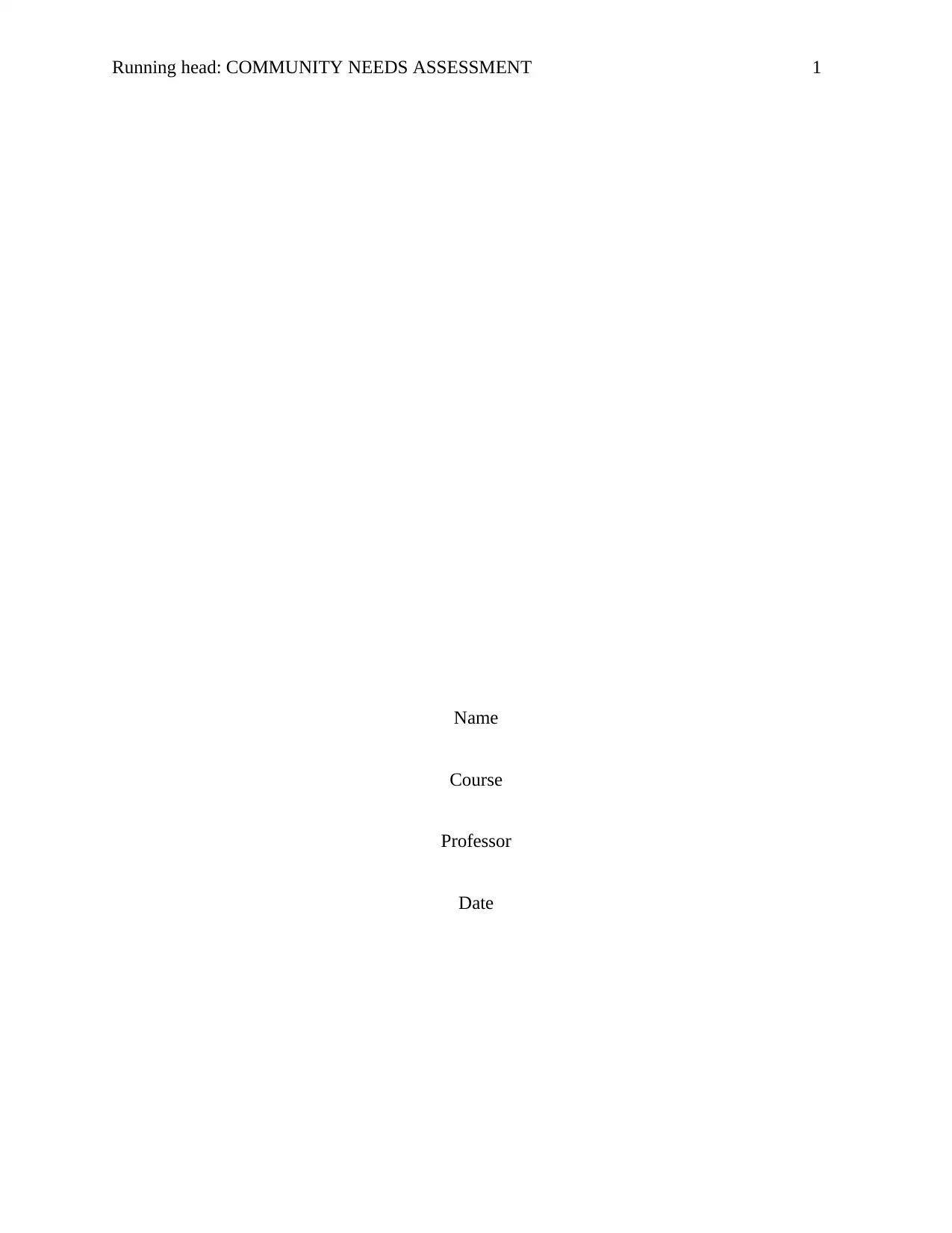
Running head: COMMUNITY NEEDS ASSESSMENT 1
Name
Course
Professor
Date
Name
Course
Professor
Date
Secure Best Marks with AI Grader
Need help grading? Try our AI Grader for instant feedback on your assignments.
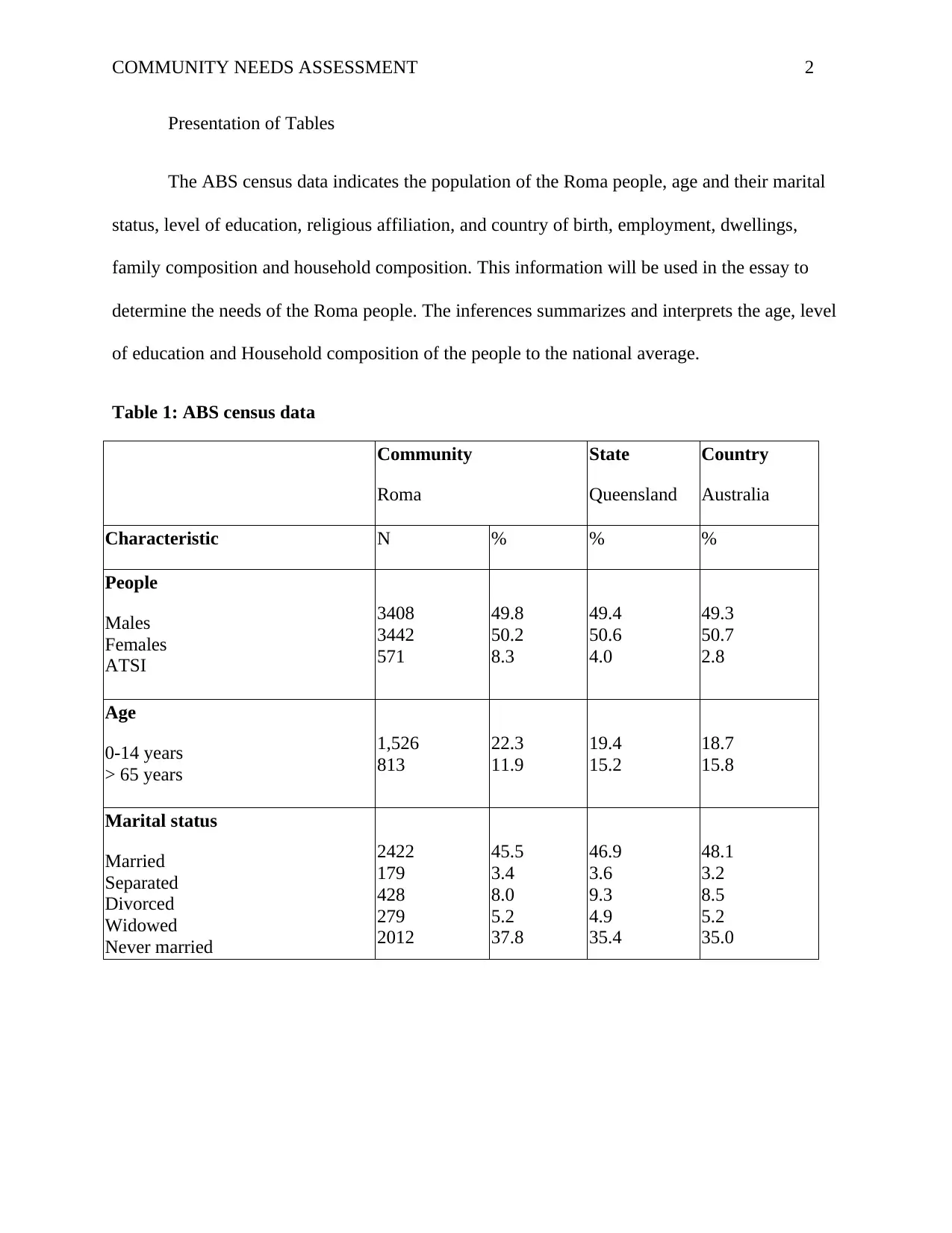
COMMUNITY NEEDS ASSESSMENT 2
Presentation of Tables
The ABS census data indicates the population of the Roma people, age and their marital
status, level of education, religious affiliation, and country of birth, employment, dwellings,
family composition and household composition. This information will be used in the essay to
determine the needs of the Roma people. The inferences summarizes and interprets the age, level
of education and Household composition of the people to the national average.
Table 1: ABS census data
Community
Roma
State
Queensland
Country
Australia
Characteristic N % % %
People
Males
Females
ATSI
3408
3442
571
49.8
50.2
8.3
49.4
50.6
4.0
49.3
50.7
2.8
Age
0-14 years
> 65 years
1,526
813
22.3
11.9
19.4
15.2
18.7
15.8
Marital status
Married
Separated
Divorced
Widowed
Never married
2422
179
428
279
2012
45.5
3.4
8.0
5.2
37.8
46.9
3.6
9.3
4.9
35.4
48.1
3.2
8.5
5.2
35.0
Presentation of Tables
The ABS census data indicates the population of the Roma people, age and their marital
status, level of education, religious affiliation, and country of birth, employment, dwellings,
family composition and household composition. This information will be used in the essay to
determine the needs of the Roma people. The inferences summarizes and interprets the age, level
of education and Household composition of the people to the national average.
Table 1: ABS census data
Community
Roma
State
Queensland
Country
Australia
Characteristic N % % %
People
Males
Females
ATSI
3408
3442
571
49.8
50.2
8.3
49.4
50.6
4.0
49.3
50.7
2.8
Age
0-14 years
> 65 years
1,526
813
22.3
11.9
19.4
15.2
18.7
15.8
Marital status
Married
Separated
Divorced
Widowed
Never married
2422
179
428
279
2012
45.5
3.4
8.0
5.2
37.8
46.9
3.6
9.3
4.9
35.4
48.1
3.2
8.5
5.2
35.0
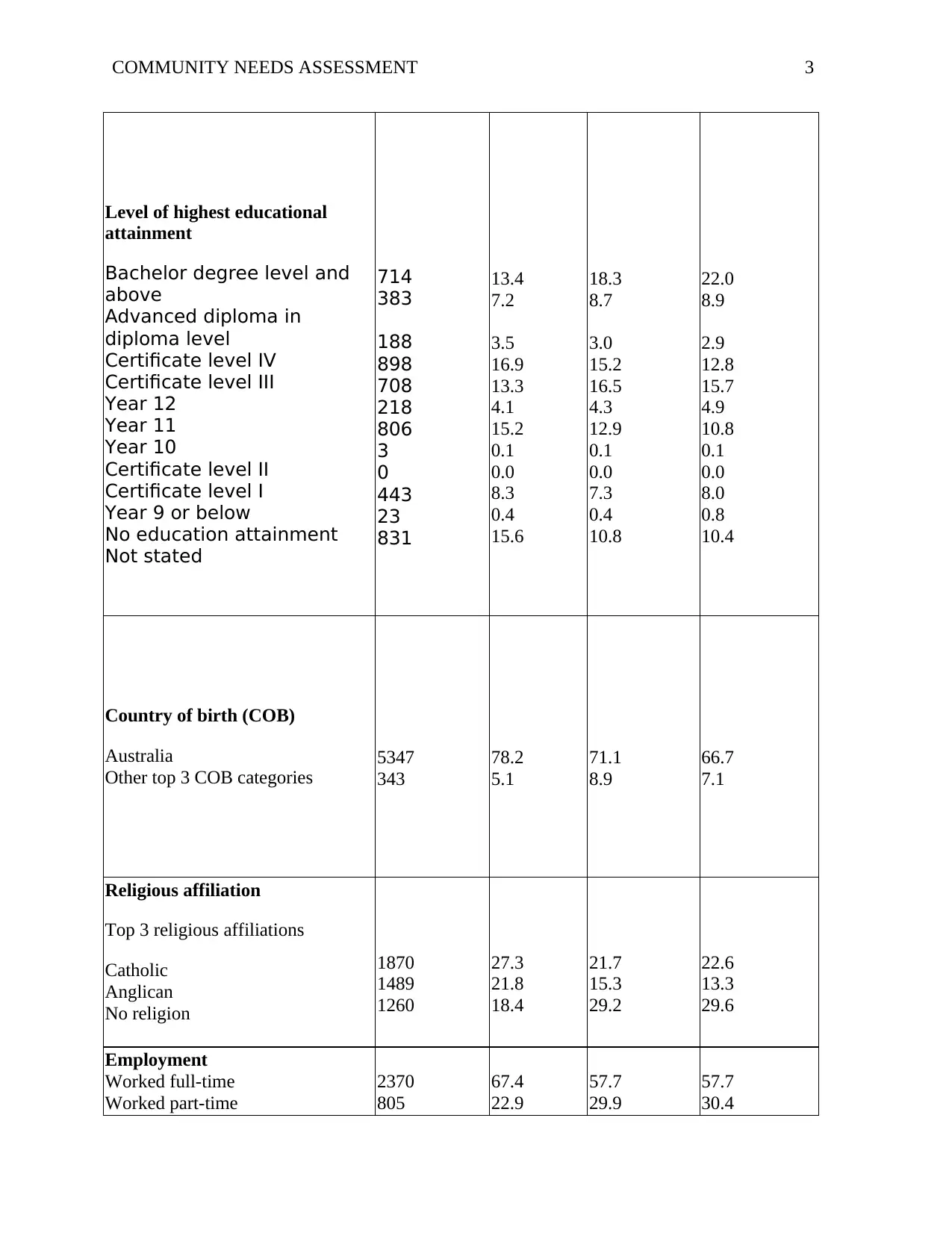
COMMUNITY NEEDS ASSESSMENT 3
Level of highest educational
attainment
Bachelor degree level and
above
Advanced diploma in
diploma level
Certificate level IV
Certificate level III
Year 12
Year 11
Year 10
Certificate level II
Certificate level I
Year 9 or below
No education attainment
Not stated
714
383
188
898
708
218
806
3
0
443
23
831
13.4
7.2
3.5
16.9
13.3
4.1
15.2
0.1
0.0
8.3
0.4
15.6
18.3
8.7
3.0
15.2
16.5
4.3
12.9
0.1
0.0
7.3
0.4
10.8
22.0
8.9
2.9
12.8
15.7
4.9
10.8
0.1
0.0
8.0
0.8
10.4
Country of birth (COB)
Australia
Other top 3 COB categories
5347
343
78.2
5.1
71.1
8.9
66.7
7.1
Religious affiliation
Top 3 religious affiliations
Catholic
Anglican
No religion
1870
1489
1260
27.3
21.8
18.4
21.7
15.3
29.2
22.6
13.3
29.6
Employment
Worked full-time
Worked part-time
2370
805
67.4
22.9
57.7
29.9
57.7
30.4
Level of highest educational
attainment
Bachelor degree level and
above
Advanced diploma in
diploma level
Certificate level IV
Certificate level III
Year 12
Year 11
Year 10
Certificate level II
Certificate level I
Year 9 or below
No education attainment
Not stated
714
383
188
898
708
218
806
3
0
443
23
831
13.4
7.2
3.5
16.9
13.3
4.1
15.2
0.1
0.0
8.3
0.4
15.6
18.3
8.7
3.0
15.2
16.5
4.3
12.9
0.1
0.0
7.3
0.4
10.8
22.0
8.9
2.9
12.8
15.7
4.9
10.8
0.1
0.0
8.0
0.8
10.4
Country of birth (COB)
Australia
Other top 3 COB categories
5347
343
78.2
5.1
71.1
8.9
66.7
7.1
Religious affiliation
Top 3 religious affiliations
Catholic
Anglican
No religion
1870
1489
1260
27.3
21.8
18.4
21.7
15.3
29.2
22.6
13.3
29.6
Employment
Worked full-time
Worked part-time
2370
805
67.4
22.9
57.7
29.9
57.7
30.4
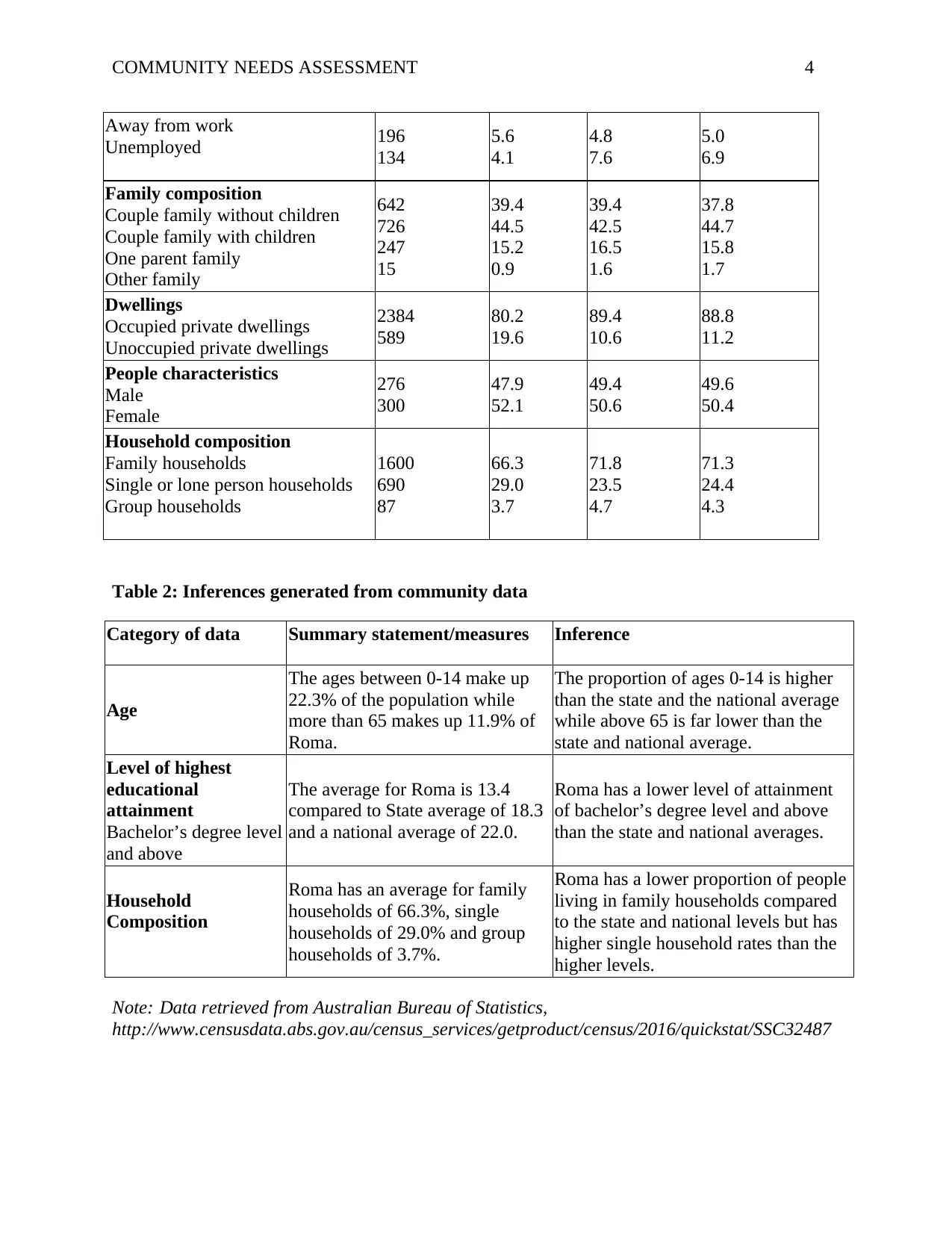
COMMUNITY NEEDS ASSESSMENT 4
Away from work
Unemployed 196
134
5.6
4.1
4.8
7.6
5.0
6.9
Family composition
Couple family without children
Couple family with children
One parent family
Other family
642
726
247
15
39.4
44.5
15.2
0.9
39.4
42.5
16.5
1.6
37.8
44.7
15.8
1.7
Dwellings
Occupied private dwellings
Unoccupied private dwellings
2384
589
80.2
19.6
89.4
10.6
88.8
11.2
People characteristics
Male
Female
276
300
47.9
52.1
49.4
50.6
49.6
50.4
Household composition
Family households
Single or lone person households
Group households
1600
690
87
66.3
29.0
3.7
71.8
23.5
4.7
71.3
24.4
4.3
Table 2: Inferences generated from community data
Category of data Summary statement/measures Inference
Age
The ages between 0-14 make up
22.3% of the population while
more than 65 makes up 11.9% of
Roma.
The proportion of ages 0-14 is higher
than the state and the national average
while above 65 is far lower than the
state and national average.
Level of highest
educational
attainment
Bachelor’s degree level
and above
The average for Roma is 13.4
compared to State average of 18.3
and a national average of 22.0.
Roma has a lower level of attainment
of bachelor’s degree level and above
than the state and national averages.
Household
Composition
Roma has an average for family
households of 66.3%, single
households of 29.0% and group
households of 3.7%.
Roma has a lower proportion of people
living in family households compared
to the state and national levels but has
higher single household rates than the
higher levels.
Note: Data retrieved from Australian Bureau of Statistics,
http://www.censusdata.abs.gov.au/census_services/getproduct/census/2016/quickstat/SSC32487
Away from work
Unemployed 196
134
5.6
4.1
4.8
7.6
5.0
6.9
Family composition
Couple family without children
Couple family with children
One parent family
Other family
642
726
247
15
39.4
44.5
15.2
0.9
39.4
42.5
16.5
1.6
37.8
44.7
15.8
1.7
Dwellings
Occupied private dwellings
Unoccupied private dwellings
2384
589
80.2
19.6
89.4
10.6
88.8
11.2
People characteristics
Male
Female
276
300
47.9
52.1
49.4
50.6
49.6
50.4
Household composition
Family households
Single or lone person households
Group households
1600
690
87
66.3
29.0
3.7
71.8
23.5
4.7
71.3
24.4
4.3
Table 2: Inferences generated from community data
Category of data Summary statement/measures Inference
Age
The ages between 0-14 make up
22.3% of the population while
more than 65 makes up 11.9% of
Roma.
The proportion of ages 0-14 is higher
than the state and the national average
while above 65 is far lower than the
state and national average.
Level of highest
educational
attainment
Bachelor’s degree level
and above
The average for Roma is 13.4
compared to State average of 18.3
and a national average of 22.0.
Roma has a lower level of attainment
of bachelor’s degree level and above
than the state and national averages.
Household
Composition
Roma has an average for family
households of 66.3%, single
households of 29.0% and group
households of 3.7%.
Roma has a lower proportion of people
living in family households compared
to the state and national levels but has
higher single household rates than the
higher levels.
Note: Data retrieved from Australian Bureau of Statistics,
http://www.censusdata.abs.gov.au/census_services/getproduct/census/2016/quickstat/SSC32487
Secure Best Marks with AI Grader
Need help grading? Try our AI Grader for instant feedback on your assignments.
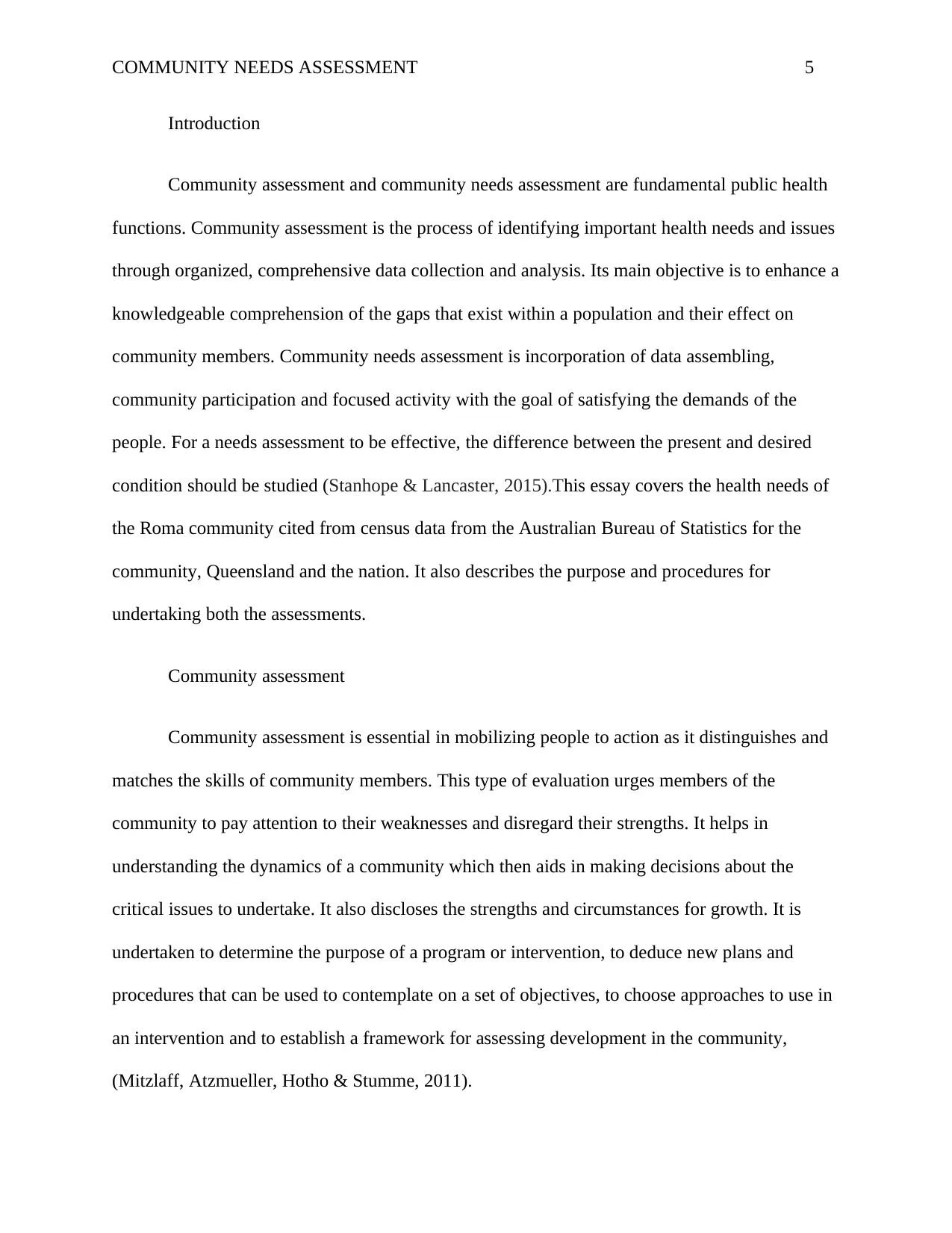
COMMUNITY NEEDS ASSESSMENT 5
Introduction
Community assessment and community needs assessment are fundamental public health
functions. Community assessment is the process of identifying important health needs and issues
through organized, comprehensive data collection and analysis. Its main objective is to enhance a
knowledgeable comprehension of the gaps that exist within a population and their effect on
community members. Community needs assessment is incorporation of data assembling,
community participation and focused activity with the goal of satisfying the demands of the
people. For a needs assessment to be effective, the difference between the present and desired
condition should be studied (Stanhope & Lancaster, 2015).This essay covers the health needs of
the Roma community cited from census data from the Australian Bureau of Statistics for the
community, Queensland and the nation. It also describes the purpose and procedures for
undertaking both the assessments.
Community assessment
Community assessment is essential in mobilizing people to action as it distinguishes and
matches the skills of community members. This type of evaluation urges members of the
community to pay attention to their weaknesses and disregard their strengths. It helps in
understanding the dynamics of a community which then aids in making decisions about the
critical issues to undertake. It also discloses the strengths and circumstances for growth. It is
undertaken to determine the purpose of a program or intervention, to deduce new plans and
procedures that can be used to contemplate on a set of objectives, to choose approaches to use in
an intervention and to establish a framework for assessing development in the community,
(Mitzlaff, Atzmueller, Hotho & Stumme, 2011).
Introduction
Community assessment and community needs assessment are fundamental public health
functions. Community assessment is the process of identifying important health needs and issues
through organized, comprehensive data collection and analysis. Its main objective is to enhance a
knowledgeable comprehension of the gaps that exist within a population and their effect on
community members. Community needs assessment is incorporation of data assembling,
community participation and focused activity with the goal of satisfying the demands of the
people. For a needs assessment to be effective, the difference between the present and desired
condition should be studied (Stanhope & Lancaster, 2015).This essay covers the health needs of
the Roma community cited from census data from the Australian Bureau of Statistics for the
community, Queensland and the nation. It also describes the purpose and procedures for
undertaking both the assessments.
Community assessment
Community assessment is essential in mobilizing people to action as it distinguishes and
matches the skills of community members. This type of evaluation urges members of the
community to pay attention to their weaknesses and disregard their strengths. It helps in
understanding the dynamics of a community which then aids in making decisions about the
critical issues to undertake. It also discloses the strengths and circumstances for growth. It is
undertaken to determine the purpose of a program or intervention, to deduce new plans and
procedures that can be used to contemplate on a set of objectives, to choose approaches to use in
an intervention and to establish a framework for assessing development in the community,
(Mitzlaff, Atzmueller, Hotho & Stumme, 2011).
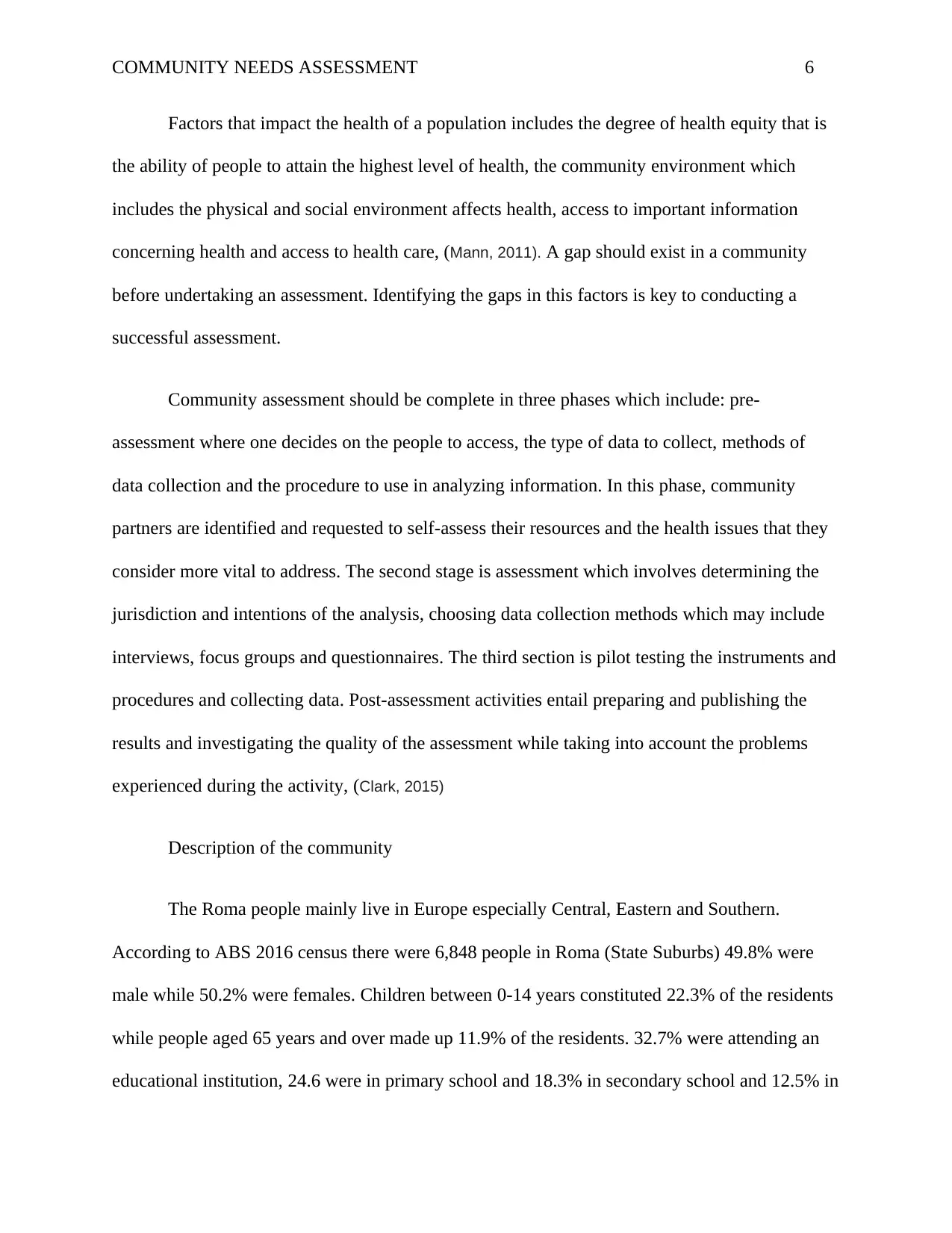
COMMUNITY NEEDS ASSESSMENT 6
Factors that impact the health of a population includes the degree of health equity that is
the ability of people to attain the highest level of health, the community environment which
includes the physical and social environment affects health, access to important information
concerning health and access to health care, (Mann, 2011). A gap should exist in a community
before undertaking an assessment. Identifying the gaps in this factors is key to conducting a
successful assessment.
Community assessment should be complete in three phases which include: pre-
assessment where one decides on the people to access, the type of data to collect, methods of
data collection and the procedure to use in analyzing information. In this phase, community
partners are identified and requested to self-assess their resources and the health issues that they
consider more vital to address. The second stage is assessment which involves determining the
jurisdiction and intentions of the analysis, choosing data collection methods which may include
interviews, focus groups and questionnaires. The third section is pilot testing the instruments and
procedures and collecting data. Post-assessment activities entail preparing and publishing the
results and investigating the quality of the assessment while taking into account the problems
experienced during the activity, (Clark, 2015)
Description of the community
The Roma people mainly live in Europe especially Central, Eastern and Southern.
According to ABS 2016 census there were 6,848 people in Roma (State Suburbs) 49.8% were
male while 50.2% were females. Children between 0-14 years constituted 22.3% of the residents
while people aged 65 years and over made up 11.9% of the residents. 32.7% were attending an
educational institution, 24.6 were in primary school and 18.3% in secondary school and 12.5% in
Factors that impact the health of a population includes the degree of health equity that is
the ability of people to attain the highest level of health, the community environment which
includes the physical and social environment affects health, access to important information
concerning health and access to health care, (Mann, 2011). A gap should exist in a community
before undertaking an assessment. Identifying the gaps in this factors is key to conducting a
successful assessment.
Community assessment should be complete in three phases which include: pre-
assessment where one decides on the people to access, the type of data to collect, methods of
data collection and the procedure to use in analyzing information. In this phase, community
partners are identified and requested to self-assess their resources and the health issues that they
consider more vital to address. The second stage is assessment which involves determining the
jurisdiction and intentions of the analysis, choosing data collection methods which may include
interviews, focus groups and questionnaires. The third section is pilot testing the instruments and
procedures and collecting data. Post-assessment activities entail preparing and publishing the
results and investigating the quality of the assessment while taking into account the problems
experienced during the activity, (Clark, 2015)
Description of the community
The Roma people mainly live in Europe especially Central, Eastern and Southern.
According to ABS 2016 census there were 6,848 people in Roma (State Suburbs) 49.8% were
male while 50.2% were females. Children between 0-14 years constituted 22.3% of the residents
while people aged 65 years and over made up 11.9% of the residents. 32.7% were attending an
educational institution, 24.6 were in primary school and 18.3% in secondary school and 12.5% in
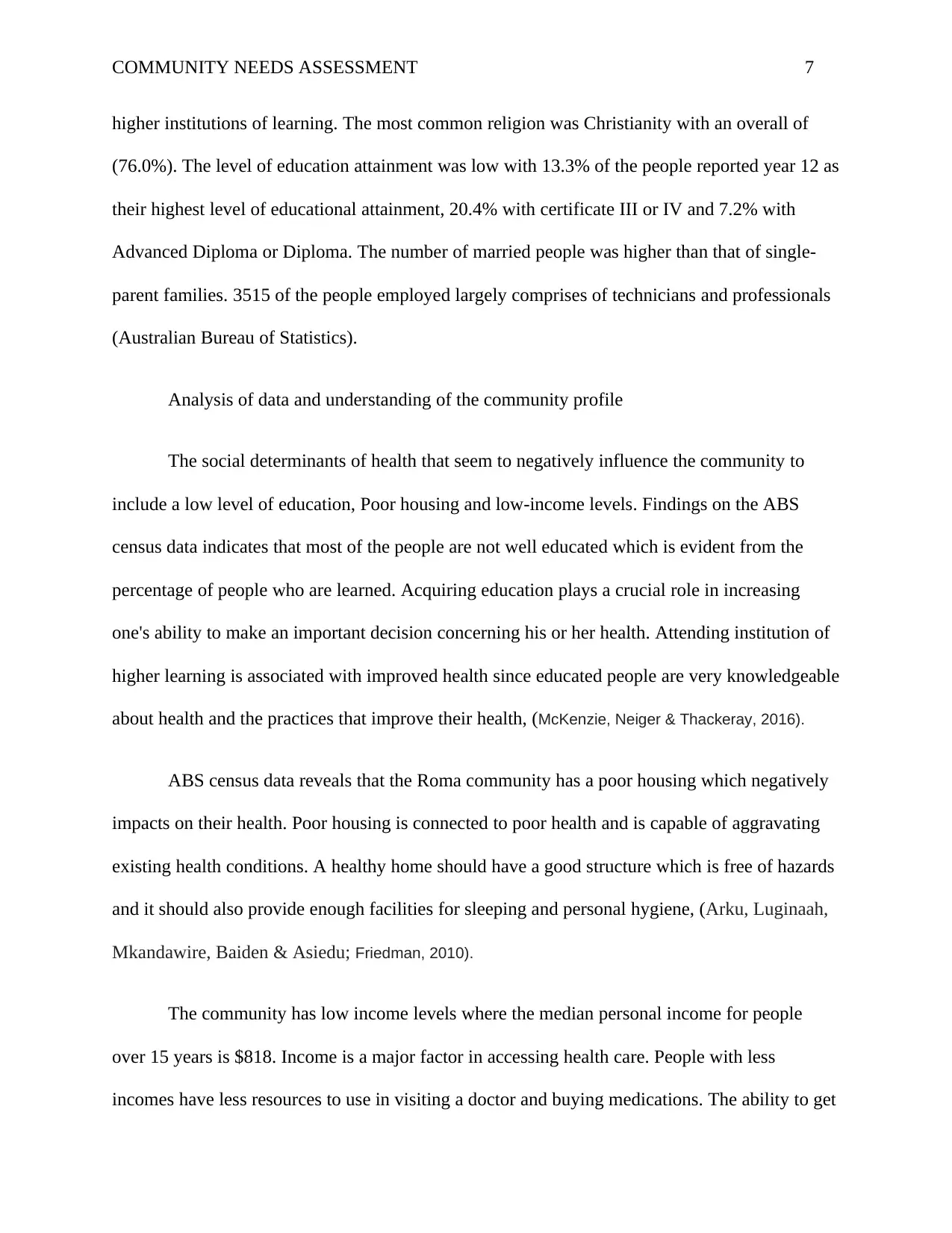
COMMUNITY NEEDS ASSESSMENT 7
higher institutions of learning. The most common religion was Christianity with an overall of
(76.0%). The level of education attainment was low with 13.3% of the people reported year 12 as
their highest level of educational attainment, 20.4% with certificate III or IV and 7.2% with
Advanced Diploma or Diploma. The number of married people was higher than that of single-
parent families. 3515 of the people employed largely comprises of technicians and professionals
(Australian Bureau of Statistics).
Analysis of data and understanding of the community profile
The social determinants of health that seem to negatively influence the community to
include a low level of education, Poor housing and low-income levels. Findings on the ABS
census data indicates that most of the people are not well educated which is evident from the
percentage of people who are learned. Acquiring education plays a crucial role in increasing
one's ability to make an important decision concerning his or her health. Attending institution of
higher learning is associated with improved health since educated people are very knowledgeable
about health and the practices that improve their health, (McKenzie, Neiger & Thackeray, 2016).
ABS census data reveals that the Roma community has a poor housing which negatively
impacts on their health. Poor housing is connected to poor health and is capable of aggravating
existing health conditions. A healthy home should have a good structure which is free of hazards
and it should also provide enough facilities for sleeping and personal hygiene, (Arku, Luginaah,
Mkandawire, Baiden & Asiedu; Friedman, 2010).
The community has low income levels where the median personal income for people
over 15 years is $818. Income is a major factor in accessing health care. People with less
incomes have less resources to use in visiting a doctor and buying medications. The ability to get
higher institutions of learning. The most common religion was Christianity with an overall of
(76.0%). The level of education attainment was low with 13.3% of the people reported year 12 as
their highest level of educational attainment, 20.4% with certificate III or IV and 7.2% with
Advanced Diploma or Diploma. The number of married people was higher than that of single-
parent families. 3515 of the people employed largely comprises of technicians and professionals
(Australian Bureau of Statistics).
Analysis of data and understanding of the community profile
The social determinants of health that seem to negatively influence the community to
include a low level of education, Poor housing and low-income levels. Findings on the ABS
census data indicates that most of the people are not well educated which is evident from the
percentage of people who are learned. Acquiring education plays a crucial role in increasing
one's ability to make an important decision concerning his or her health. Attending institution of
higher learning is associated with improved health since educated people are very knowledgeable
about health and the practices that improve their health, (McKenzie, Neiger & Thackeray, 2016).
ABS census data reveals that the Roma community has a poor housing which negatively
impacts on their health. Poor housing is connected to poor health and is capable of aggravating
existing health conditions. A healthy home should have a good structure which is free of hazards
and it should also provide enough facilities for sleeping and personal hygiene, (Arku, Luginaah,
Mkandawire, Baiden & Asiedu; Friedman, 2010).
The community has low income levels where the median personal income for people
over 15 years is $818. Income is a major factor in accessing health care. People with less
incomes have less resources to use in visiting a doctor and buying medications. The ability to get
Paraphrase This Document
Need a fresh take? Get an instant paraphrase of this document with our AI Paraphraser
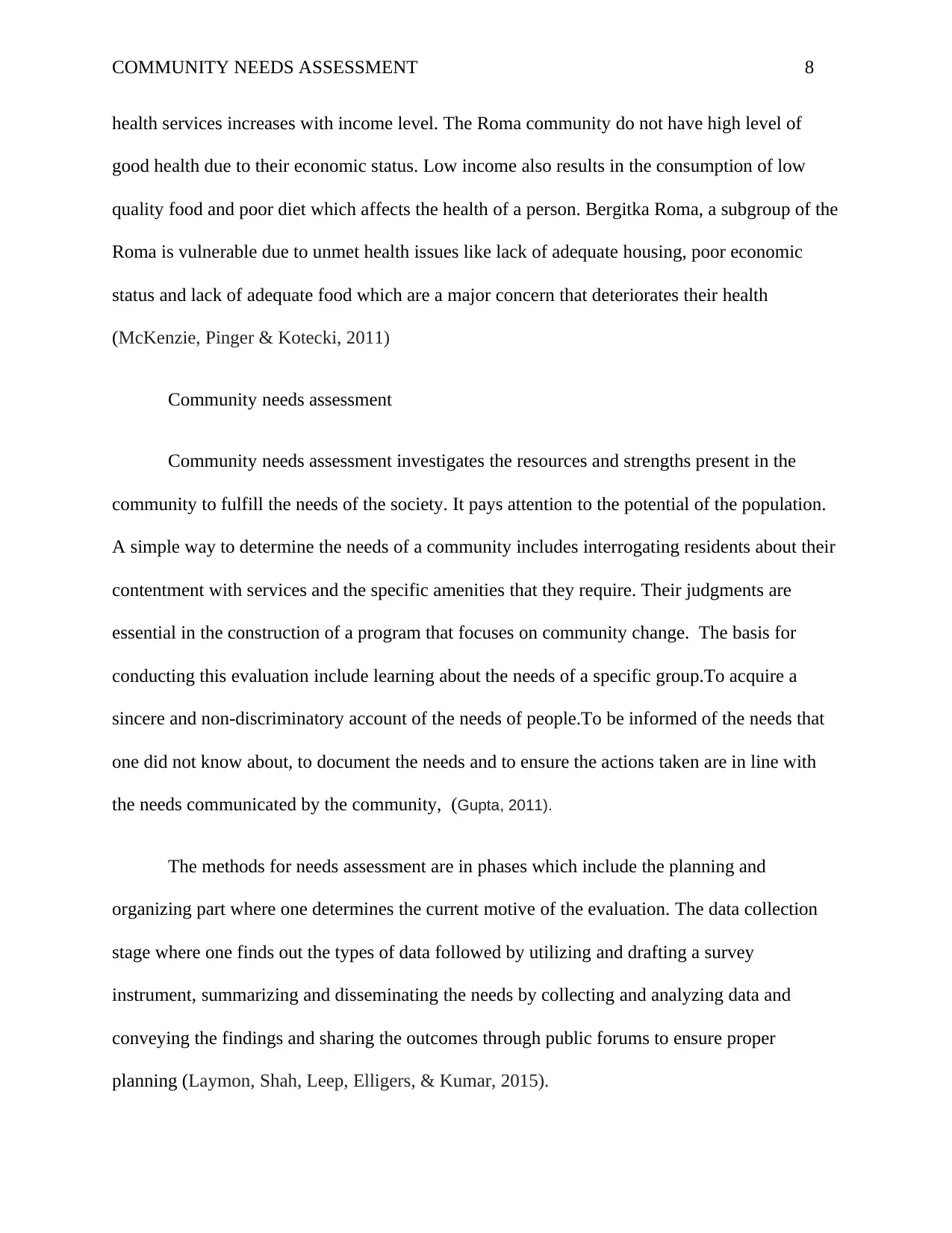
COMMUNITY NEEDS ASSESSMENT 8
health services increases with income level. The Roma community do not have high level of
good health due to their economic status. Low income also results in the consumption of low
quality food and poor diet which affects the health of a person. Bergitka Roma, a subgroup of the
Roma is vulnerable due to unmet health issues like lack of adequate housing, poor economic
status and lack of adequate food which are a major concern that deteriorates their health
(McKenzie, Pinger & Kotecki, 2011)
Community needs assessment
Community needs assessment investigates the resources and strengths present in the
community to fulfill the needs of the society. It pays attention to the potential of the population.
A simple way to determine the needs of a community includes interrogating residents about their
contentment with services and the specific amenities that they require. Their judgments are
essential in the construction of a program that focuses on community change. The basis for
conducting this evaluation include learning about the needs of a specific group.To acquire a
sincere and non-discriminatory account of the needs of people.To be informed of the needs that
one did not know about, to document the needs and to ensure the actions taken are in line with
the needs communicated by the community, (Gupta, 2011).
The methods for needs assessment are in phases which include the planning and
organizing part where one determines the current motive of the evaluation. The data collection
stage where one finds out the types of data followed by utilizing and drafting a survey
instrument, summarizing and disseminating the needs by collecting and analyzing data and
conveying the findings and sharing the outcomes through public forums to ensure proper
planning (Laymon, Shah, Leep, Elligers, & Kumar, 2015).
health services increases with income level. The Roma community do not have high level of
good health due to their economic status. Low income also results in the consumption of low
quality food and poor diet which affects the health of a person. Bergitka Roma, a subgroup of the
Roma is vulnerable due to unmet health issues like lack of adequate housing, poor economic
status and lack of adequate food which are a major concern that deteriorates their health
(McKenzie, Pinger & Kotecki, 2011)
Community needs assessment
Community needs assessment investigates the resources and strengths present in the
community to fulfill the needs of the society. It pays attention to the potential of the population.
A simple way to determine the needs of a community includes interrogating residents about their
contentment with services and the specific amenities that they require. Their judgments are
essential in the construction of a program that focuses on community change. The basis for
conducting this evaluation include learning about the needs of a specific group.To acquire a
sincere and non-discriminatory account of the needs of people.To be informed of the needs that
one did not know about, to document the needs and to ensure the actions taken are in line with
the needs communicated by the community, (Gupta, 2011).
The methods for needs assessment are in phases which include the planning and
organizing part where one determines the current motive of the evaluation. The data collection
stage where one finds out the types of data followed by utilizing and drafting a survey
instrument, summarizing and disseminating the needs by collecting and analyzing data and
conveying the findings and sharing the outcomes through public forums to ensure proper
planning (Laymon, Shah, Leep, Elligers, & Kumar, 2015).
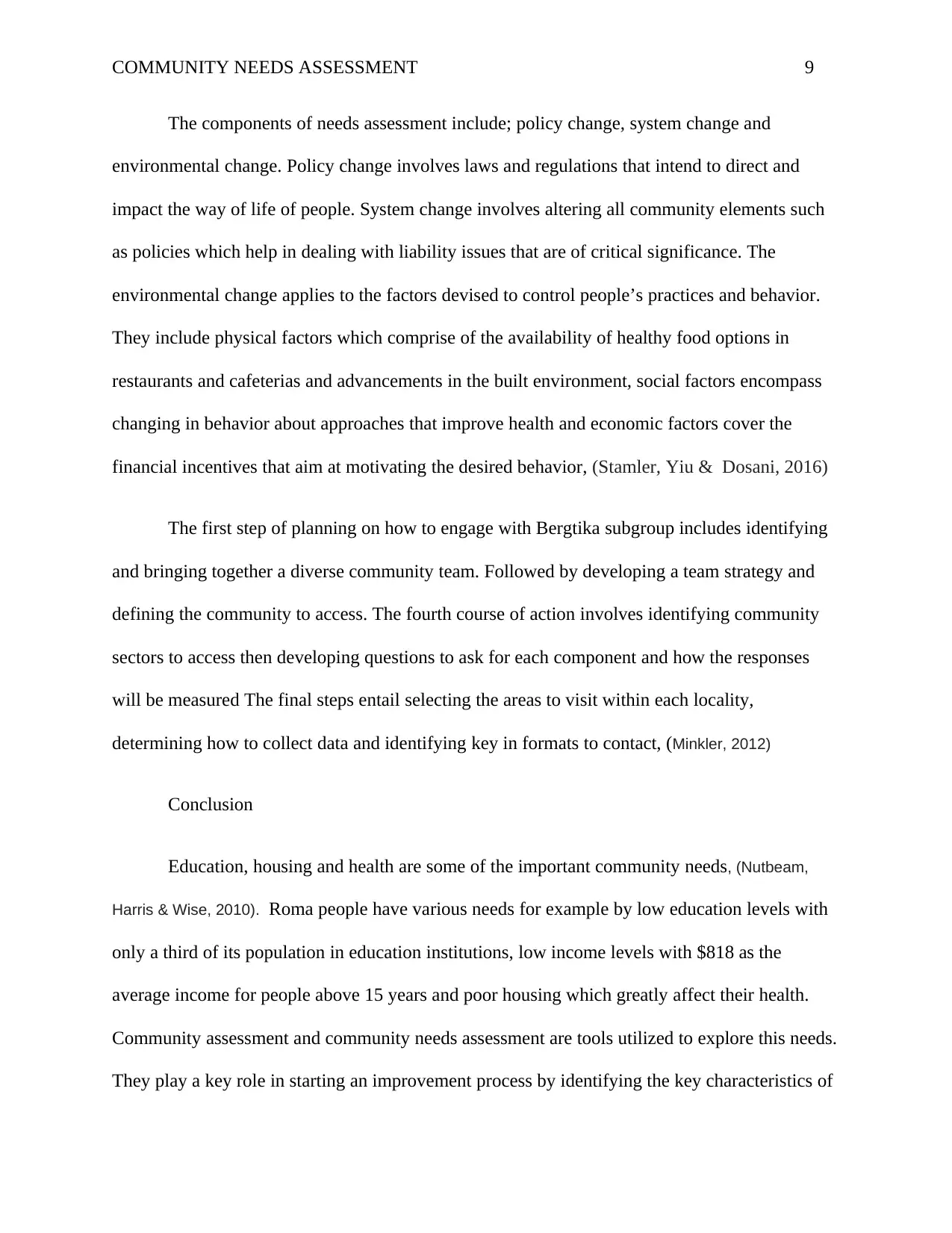
COMMUNITY NEEDS ASSESSMENT 9
The components of needs assessment include; policy change, system change and
environmental change. Policy change involves laws and regulations that intend to direct and
impact the way of life of people. System change involves altering all community elements such
as policies which help in dealing with liability issues that are of critical significance. The
environmental change applies to the factors devised to control people’s practices and behavior.
They include physical factors which comprise of the availability of healthy food options in
restaurants and cafeterias and advancements in the built environment, social factors encompass
changing in behavior about approaches that improve health and economic factors cover the
financial incentives that aim at motivating the desired behavior, (Stamler, Yiu & Dosani, 2016)
The first step of planning on how to engage with Bergtika subgroup includes identifying
and bringing together a diverse community team. Followed by developing a team strategy and
defining the community to access. The fourth course of action involves identifying community
sectors to access then developing questions to ask for each component and how the responses
will be measured The final steps entail selecting the areas to visit within each locality,
determining how to collect data and identifying key in formats to contact, (Minkler, 2012)
Conclusion
Education, housing and health are some of the important community needs, (Nutbeam,
Harris & Wise, 2010). Roma people have various needs for example by low education levels with
only a third of its population in education institutions, low income levels with $818 as the
average income for people above 15 years and poor housing which greatly affect their health.
Community assessment and community needs assessment are tools utilized to explore this needs.
They play a key role in starting an improvement process by identifying the key characteristics of
The components of needs assessment include; policy change, system change and
environmental change. Policy change involves laws and regulations that intend to direct and
impact the way of life of people. System change involves altering all community elements such
as policies which help in dealing with liability issues that are of critical significance. The
environmental change applies to the factors devised to control people’s practices and behavior.
They include physical factors which comprise of the availability of healthy food options in
restaurants and cafeterias and advancements in the built environment, social factors encompass
changing in behavior about approaches that improve health and economic factors cover the
financial incentives that aim at motivating the desired behavior, (Stamler, Yiu & Dosani, 2016)
The first step of planning on how to engage with Bergtika subgroup includes identifying
and bringing together a diverse community team. Followed by developing a team strategy and
defining the community to access. The fourth course of action involves identifying community
sectors to access then developing questions to ask for each component and how the responses
will be measured The final steps entail selecting the areas to visit within each locality,
determining how to collect data and identifying key in formats to contact, (Minkler, 2012)
Conclusion
Education, housing and health are some of the important community needs, (Nutbeam,
Harris & Wise, 2010). Roma people have various needs for example by low education levels with
only a third of its population in education institutions, low income levels with $818 as the
average income for people above 15 years and poor housing which greatly affect their health.
Community assessment and community needs assessment are tools utilized to explore this needs.
They play a key role in starting an improvement process by identifying the key characteristics of
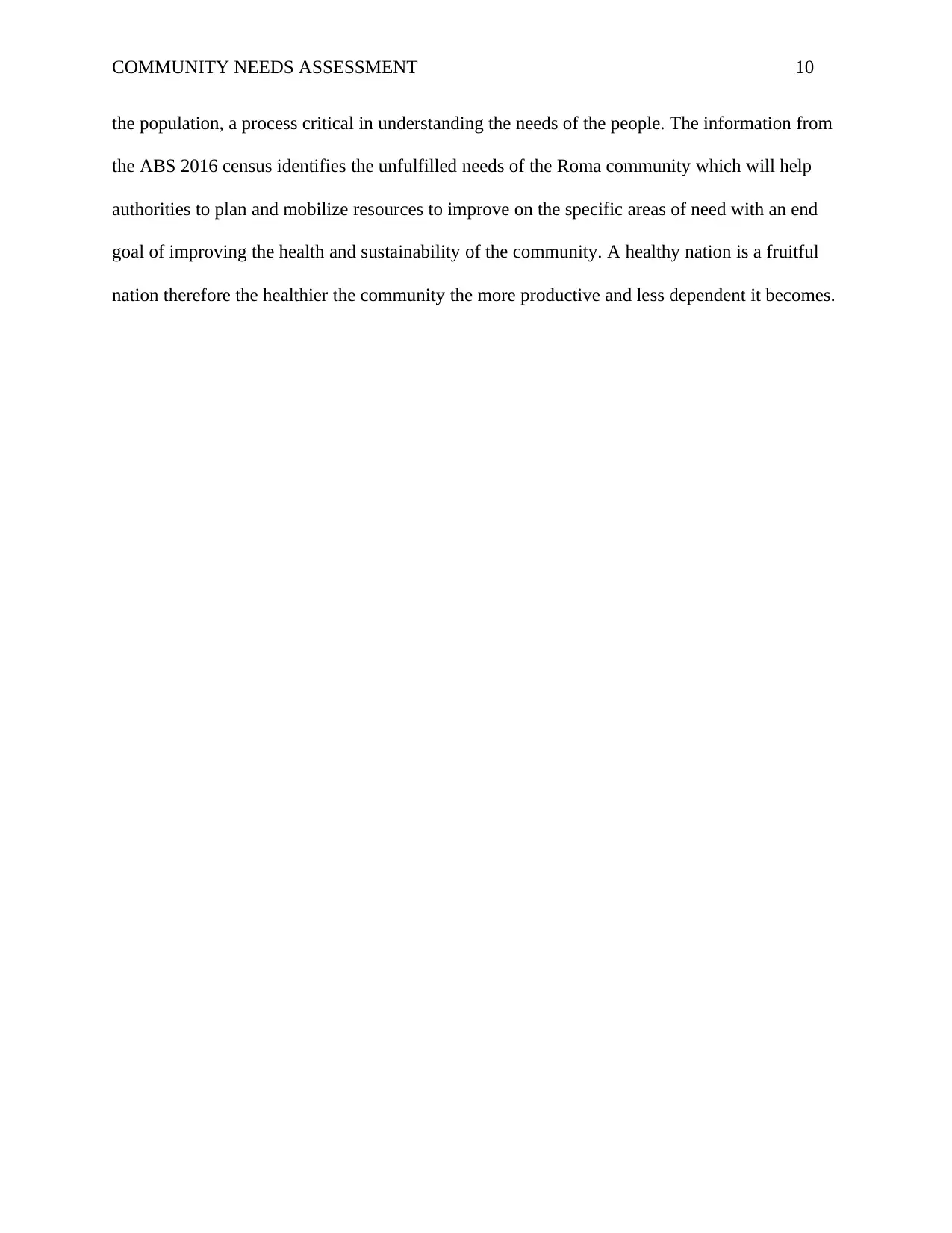
COMMUNITY NEEDS ASSESSMENT 10
the population, a process critical in understanding the needs of the people. The information from
the ABS 2016 census identifies the unfulfilled needs of the Roma community which will help
authorities to plan and mobilize resources to improve on the specific areas of need with an end
goal of improving the health and sustainability of the community. A healthy nation is a fruitful
nation therefore the healthier the community the more productive and less dependent it becomes.
the population, a process critical in understanding the needs of the people. The information from
the ABS 2016 census identifies the unfulfilled needs of the Roma community which will help
authorities to plan and mobilize resources to improve on the specific areas of need with an end
goal of improving the health and sustainability of the community. A healthy nation is a fruitful
nation therefore the healthier the community the more productive and less dependent it becomes.
Secure Best Marks with AI Grader
Need help grading? Try our AI Grader for instant feedback on your assignments.
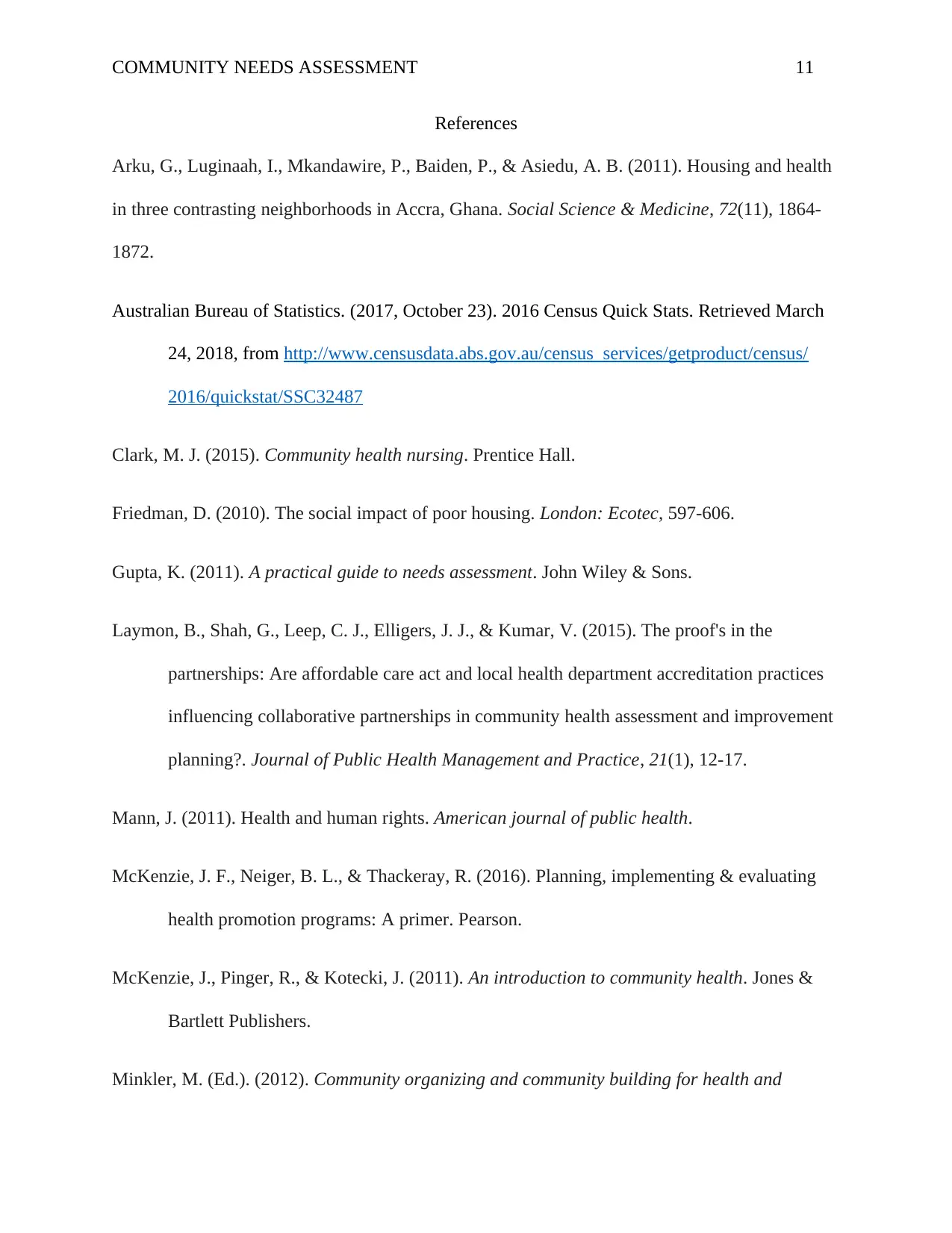
COMMUNITY NEEDS ASSESSMENT 11
References
Arku, G., Luginaah, I., Mkandawire, P., Baiden, P., & Asiedu, A. B. (2011). Housing and health
in three contrasting neighborhoods in Accra, Ghana. Social Science & Medicine, 72(11), 1864-
1872.
Australian Bureau of Statistics. (2017, October 23). 2016 Census Quick Stats. Retrieved March
24, 2018, from http://www.censusdata.abs.gov.au/census_services/getproduct/census/
2016/quickstat/SSC32487
Clark, M. J. (2015). Community health nursing. Prentice Hall.
Friedman, D. (2010). The social impact of poor housing. London: Ecotec, 597-606.
Gupta, K. (2011). A practical guide to needs assessment. John Wiley & Sons.
Laymon, B., Shah, G., Leep, C. J., Elligers, J. J., & Kumar, V. (2015). The proof's in the
partnerships: Are affordable care act and local health department accreditation practices
influencing collaborative partnerships in community health assessment and improvement
planning?. Journal of Public Health Management and Practice, 21(1), 12-17.
Mann, J. (2011). Health and human rights. American journal of public health.
McKenzie, J. F., Neiger, B. L., & Thackeray, R. (2016). Planning, implementing & evaluating
health promotion programs: A primer. Pearson.
McKenzie, J., Pinger, R., & Kotecki, J. (2011). An introduction to community health. Jones &
Bartlett Publishers.
Minkler, M. (Ed.). (2012). Community organizing and community building for health and
References
Arku, G., Luginaah, I., Mkandawire, P., Baiden, P., & Asiedu, A. B. (2011). Housing and health
in three contrasting neighborhoods in Accra, Ghana. Social Science & Medicine, 72(11), 1864-
1872.
Australian Bureau of Statistics. (2017, October 23). 2016 Census Quick Stats. Retrieved March
24, 2018, from http://www.censusdata.abs.gov.au/census_services/getproduct/census/
2016/quickstat/SSC32487
Clark, M. J. (2015). Community health nursing. Prentice Hall.
Friedman, D. (2010). The social impact of poor housing. London: Ecotec, 597-606.
Gupta, K. (2011). A practical guide to needs assessment. John Wiley & Sons.
Laymon, B., Shah, G., Leep, C. J., Elligers, J. J., & Kumar, V. (2015). The proof's in the
partnerships: Are affordable care act and local health department accreditation practices
influencing collaborative partnerships in community health assessment and improvement
planning?. Journal of Public Health Management and Practice, 21(1), 12-17.
Mann, J. (2011). Health and human rights. American journal of public health.
McKenzie, J. F., Neiger, B. L., & Thackeray, R. (2016). Planning, implementing & evaluating
health promotion programs: A primer. Pearson.
McKenzie, J., Pinger, R., & Kotecki, J. (2011). An introduction to community health. Jones &
Bartlett Publishers.
Minkler, M. (Ed.). (2012). Community organizing and community building for health and
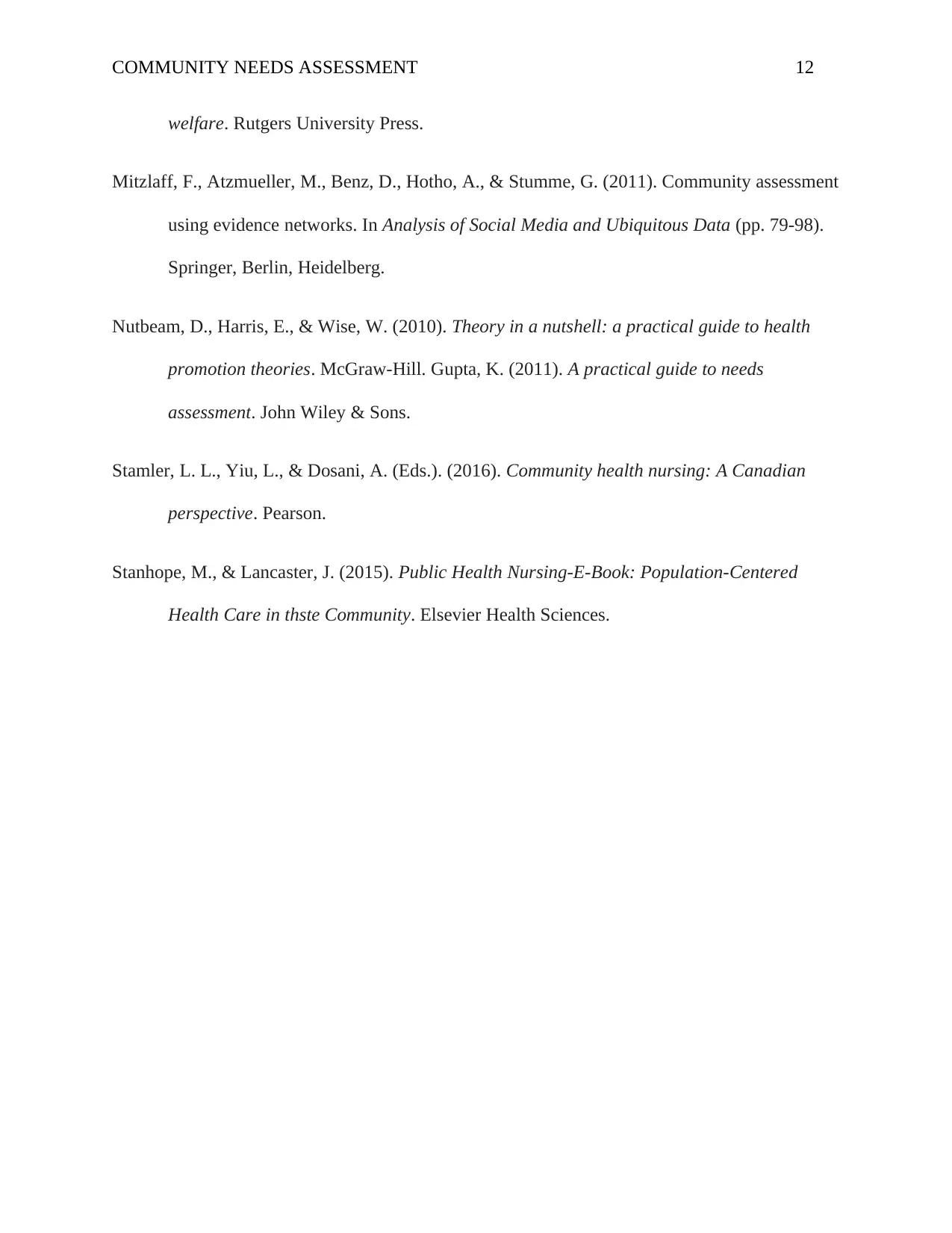
COMMUNITY NEEDS ASSESSMENT 12
welfare. Rutgers University Press.
Mitzlaff, F., Atzmueller, M., Benz, D., Hotho, A., & Stumme, G. (2011). Community assessment
using evidence networks. In Analysis of Social Media and Ubiquitous Data (pp. 79-98).
Springer, Berlin, Heidelberg.
Nutbeam, D., Harris, E., & Wise, W. (2010). Theory in a nutshell: a practical guide to health
promotion theories. McGraw-Hill. Gupta, K. (2011). A practical guide to needs
assessment. John Wiley & Sons.
Stamler, L. L., Yiu, L., & Dosani, A. (Eds.). (2016). Community health nursing: A Canadian
perspective. Pearson.
Stanhope, M., & Lancaster, J. (2015). Public Health Nursing-E-Book: Population-Centered
Health Care in thste Community. Elsevier Health Sciences.
welfare. Rutgers University Press.
Mitzlaff, F., Atzmueller, M., Benz, D., Hotho, A., & Stumme, G. (2011). Community assessment
using evidence networks. In Analysis of Social Media and Ubiquitous Data (pp. 79-98).
Springer, Berlin, Heidelberg.
Nutbeam, D., Harris, E., & Wise, W. (2010). Theory in a nutshell: a practical guide to health
promotion theories. McGraw-Hill. Gupta, K. (2011). A practical guide to needs
assessment. John Wiley & Sons.
Stamler, L. L., Yiu, L., & Dosani, A. (Eds.). (2016). Community health nursing: A Canadian
perspective. Pearson.
Stanhope, M., & Lancaster, J. (2015). Public Health Nursing-E-Book: Population-Centered
Health Care in thste Community. Elsevier Health Sciences.
1 out of 12
Your All-in-One AI-Powered Toolkit for Academic Success.
+13062052269
info@desklib.com
Available 24*7 on WhatsApp / Email
![[object Object]](/_next/static/media/star-bottom.7253800d.svg)
Unlock your academic potential
© 2024 | Zucol Services PVT LTD | All rights reserved.

